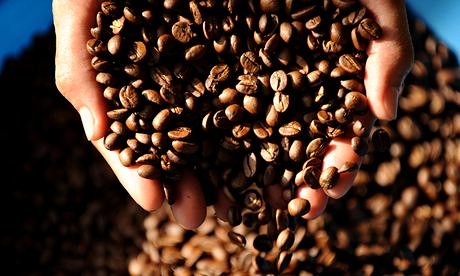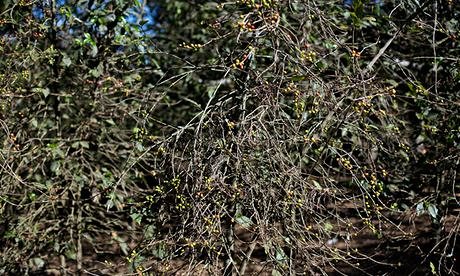
Roasted coffee beans. The rise in global temperature is of great concern for the coffee industry. Photograph: Noel Celis/AFP/Getty Images
Rich western urbanites expecting to dodge the impacts of climate change should prepare for a jolt: global warming is leading to bad, expensive coffee. Almost 2bn cups of coffee perk up its drinkers every day, but a perfect storm of rising heat, extreme weather and ferocious pests mean the highland bean is running out of cool mountainsides on which it flourishes.
"The rise in global temperature is of great concern for us in the coffee industry because it will – and has already started – putting the supply of quality coffee at great risk," said Dr Tim Schilling, executive director of the World Coffee Research programme, based at Texas A&M University. "It is also obvious that increasing temperatures – as well as extreme weather events – have a very negative affect on production. Over the long term, you will definitely see coffee prices going up as a result of climate change."
Mauricio Galindo, head of operations at the intergovernmental International Coffee Organisation, is equally worried: "Climate change is the biggest threat to the industry. If we don't prepare ourselves we are heading for a big disaster." Coffee drinkers may see the effect in their cups, but the 25m rural households around the globe whose livelihoods depend on coffee will be hit far harder.
The world's foremost climate science group, the Intergovernmental Panel on Climate Change (IPCC), will include the effect of warming on coffee as part of a landmark report published next Monday on the global impacts of climate change. It is expected to conclude: "The overall predictions are for a reduction in area suitable for coffee production by 2050 in all countries studied. In many cases, the area suitable for production would decrease considerably with increases of temperature of only 2.0-2.5C."
The IPCC will report that in Brazil, the world's biggest coffee producer, a temperature rise of 3C would slash the area suitable for coffee production by two-thirds in the principal growing states of Minas Gerais and São Paulo and eliminate it in others. While growing will become possible in states further south, this will not compensate for losses further north. An IPCC report on the science of climate change published in September projected the world will warm by 2.6-4.8C by the end of the century without deep cuts in greenhouse gas emissions.

Coffee trees are irrigated on a farm in Santo Antonio do Jardim, Brazil. For the world’s biggest coffee producer, a temperature rise of 3C would slash the area suitable for coffee production by two-thirds in the principal growing states. Photograph: Paulo Whitaker/Reuters
The dangers to coffee stem from its origins in the highlands of east Africa, where the relatively cool and stable climate found between 1,500-2,800m allows the berries to thrive. But at 23C and above, the plant's metabolism starts to race, leading to lower yields and, crucially, a failure to accumulate the right mix of aromatic volatile compounds that deliver coffee's distinctive taste.
Worse, pests like the berry borer beetle and leaf rust fungus are flourishing as the world warms. Leaf rust has already savaged recent harvests in the coffee heartlands of central America, with yields down 40% in 2013-14 compared to 2011-12. "The only way you can make sense of it is through climate change," said Galindo. "The temperature has risen and this fungus can attack with a speed and aggression we have never seen." At least 1.4 million people in Guatemala, El Salvador, Honduras and Nicaragua depend on coffee production for their livelihoods. When coffee's susceptibility to changes in climate has caused crises in the last few decades, a quarter of all households have been forced to migrate.
The pest, berry borer beetle, was unknown until about 2000 in Ethopia, Uganda, Burundi and Rwanda, as it preferred the warmer temperatures at lower altitudes. But warming has driven the beetles up the hillsides and into the coffee plantations and it now causes $500m damage a year. The beetle currently reproduces five times a year but further warming is expected see that to rise to 10 times. Endosulfan, the pesticide once used to control the berry borer, was banned in 2011.
Climate change is also increasing the frequency of extreme weather events, as more energy is trapped in the atmosphere. According to Galindo, 2014's severe drought in Brazil has shown how sensitive prices are to such climate impacts, with the price doubling to $2 per pound, even before the harvest.
Assessing all the combined impacts of climate change, Galindo said: "In the worst-case scenario, we will only have a few places producing coffee." Brazil, Vietnam, Indonesia, Columbia and Ethiopia are the biggest producers and will probably have the resources to attempt to adapt, he said. "But central America and Laos and Peru and Burundi and Rwanda, they are gone."

Coffee plants sit defoliated and damaged by leaf rust fungus in Guatemala, which is flourishing as the world warms. Photograph: J. Blue/Getty Images
The IPCC report will state that in some places, such as Uganda, adaptation by shifting plantation up hillsides will be impossible: they will simply reach the top and run out of land. Efforts are being made to develop new coffee varieties, to tolerate higher temperatures and resist pests. The coffee industry was worth $173bn in 2012, but Galindo said: "You need major financial means to change all your trees." Lab-based genetic engineering, like that used to insert pest-killing toxins into maize and cotton, has been ruled out by the industry due to consumer opposition.
"But the real genetic variety of coffee has never really been exploited," Schilling said. For arabica coffee, 70% of the world market, "every plant derives from only two or three Ethiopian varieties from 2,000 years ago", he said. Researchers are now working to identify the 10 or 20 most genetically diverse coffee plants from 1,000 native varieties collected in the Ethiopian forests in the 1960s by the UN Food and Agriculture Organisation, with the results expected later in 2014.
These can then be crossed and put into field trials to develop what Schilling calls "super races" of coffee. Once identified, conventional techniques can quickly deliver millions of plants.
"I am very optimistic this strategy will produce the plants we need," Schilling said. "But the weak point is the time available. It is a race – if we had started 10 years ago, we would be very confident that today we would have tools to battle climate change. But I wonder if coffee growers will be able to withstand climate change for another 10 years."



